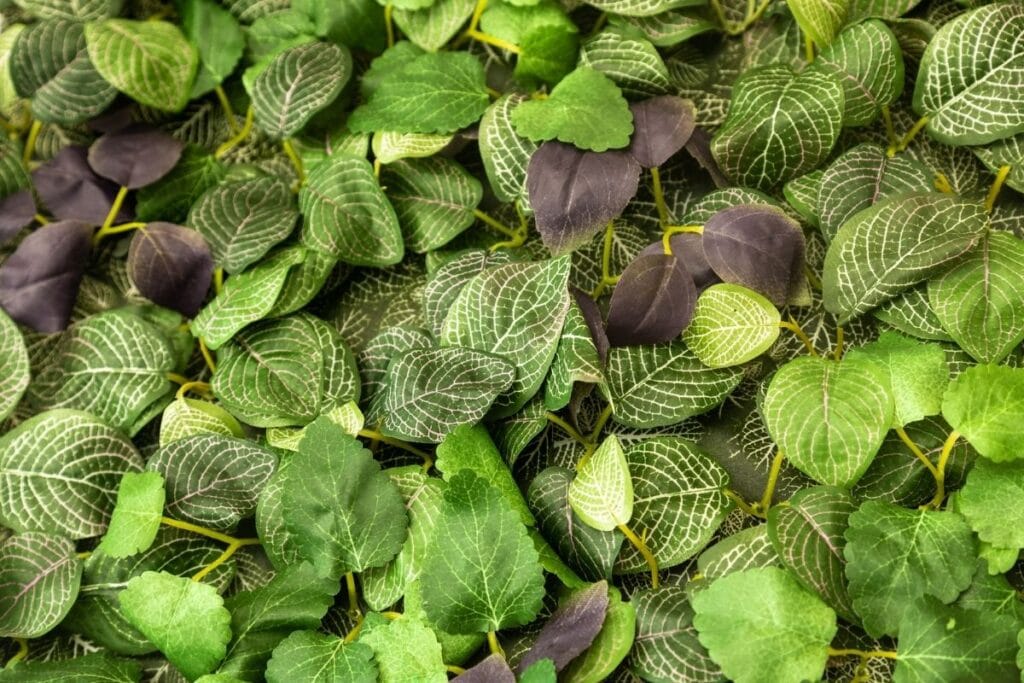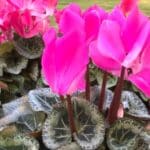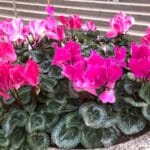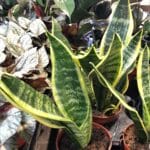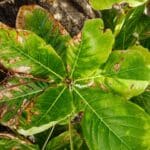The nerve plant (Fittonia albivenis) is an amazing houseplant that is grown for its vividly marked leaves. The contrast created by the brightly colored leaf venation is what really makes these miniature plants stand out. Although their specific name means ‘white veins’, there are several varieties available in cultivation with a range of different colors.
In this article, we’ll introduce you to a selection of the more popular and possible Fittonia types that you can grow. Don’t forget to check our guide to learn how to care for nerve plants.
There are a great number of different colorful nerve plant varieties available today. These plants are unofficially classified into two groups, the Argyroneura, and the Verschaffeltii groups. The taxonomy may change in the future, but these plants are currently all classified as members of Fittonia albivenis.
The Argyroneura Group
The nerve plants in this group have light-colored leaf venation in shades of white, silver, or yellow. They are commonly known as silver fittonias or fittonia argyroneura (1). You are most likely to come across the following popular Argyroneura cultivars.
‘Daisy’
‘Daisy’ is a popular nerve plant variety that is distinguishable by its leaf size and coloration. The large leaves are muted green in color with lovely white pronounced veins and larger white patterns along the margin.
‘Frankie’
This is one of the more colorful types of nerve plants where the venation color is dominant. Unlike most varieties that are greener in color, it has large gray green leaves with white or light pink veins.
‘Leather Leaf’
This variety’s ovate and leathery green foliage are laced with white to greenish-white netted patterns. The soft stems are light green in color, which creates an attractive contrast. The overall effect is a delightful combination of little green foliage textured with delicate netting.
‘Titanic’
This popular indoor plant variety has a slightly confusing name. It is, in fact, a smaller variety that has somewhat elongated small exhibiting green leaves patterned with criss-crossing white venations. Compared to superba, it has slender and narrow leaves.
‘Stripes Forever’
There is a beautiful nerve plant type called Fittonia ‘Stripes Forever’ that is loved for its bright and unique leaves. The Stripes Forever botanical name is Fittonia albivenis ‘Stripes Forever’.
It has big green leaves adorned with bright white or pink lines, making it easily recognizable. This species gives rooms a lively touch, which is why it’s often used as a ground cover, in terrariums, or hanging baskets.
‘Angel Snow’
Angel Snow (Fittonia albivenis ‘Angel Snow’) is a charming cultivar of the nerve plant cherished for its delicate beauty. Its petite, oval-shaped leaves boast a soft, snowy-white hue, adorned with intricate green veins that resemble delicate lacework. This variety adds a touch of elegance to indoor spaces, creating a serene and ethereal atmosphere.
‘Pink Angel’
The Pink Angel Fittonia is a charmer with deep green, oval leaves etched with vibrant pink veins. Pink Angel botanical name is Fittonia albivenis ‘Pink Angel’. While compact (3-6 inches tall), its trailing stems reach 12-18 inches, making it a lovely hanging or terrarium plant.
The Verschaffeltii Group
Plants from the Verschaffeltii group are also known as red mosaic plants (2). They can be distinguished by their generally darker leaf colors, with pink and red veins.
‘Fortissimo’
The ‘Fortissimo’ fittonia plant is a stunning and vibrant addition to any indoor garden. Characterized by its striking foliage, featuring intricate patterns of deep green veins against a backdrop of bright pink or red, it adds a pop of color and texture to any space.
‘Mini Red Vein’
‘Mini Red Vein’ is a small nerve plant, growing 10–15 cm (4–6 inches) tall. Its dark green leaves are laced with broad pink veins, creating an attractive contrast. This compact plant is ideal as groundcover and thrives as a houseplant or in a greenhouse. The small leaves, about 1 x 2 inches, exhibit intense pink coloring in their veins.
‘Pink Star’
‘Pink star’ is popular both for its color and the attractive wavy texture of its dark green foliage. The curled leaf margins of this entire plant are deep green and the blade is of the same color, only speckled and netted with charming pink green hues. The overall effect is a delightful combination of beautiful green foliage embellished with rich red veins.
‘Juanita’
‘Juanita’ is a delightful nerve plant with striking patterned foliage. Its rich green leaves are laced with deep red pink veins, creating an eye-catching contrast. With its charming appearance and easy care, ‘Juanita Red’ is a favorite among indoor plant enthusiasts.
‘Red Anne’
The Red Anne fittonia is a petite houseplant prized for its stunning small green leaves. Its deep green, oval-shaped leaves are adorned with striking rich purple red veins, earning it the nickname “nerve plant.” This slow-growing charmer typically reaches only 3-6 inches tall but can sprawl up to 18 inches wide.
‘Purple Vein’
Instead of the usual white and pink venations, the nerves of this fittonia are lavender in color against the dense large green leaves. The darker venation and larger-than-average leaf size of this variety make for a very attractive but understated specimen.
‘Black Star’
Fittonia verschaffeltii ‘Black Star’ is a striking variety of nerve plant, prized for its distinctive dark emerald green leaves. Its beautiful green foliage is adorned with intricate veins, creating a mesmerizing contrast against the deep burgundy or almost black background.
FAQs
How many types of Fittonia are there?
There are several cultivars of Fittonia, with common varieties including Fittonia verschaffeltii and Fittonia albivenis, each offering different leaf colors and patterns.
Why is Fittonia called a nerve plant?
Fittonia is commonly referred to as a “nerve plant” because of the prominent veins that run through its small dark green leaves, resembling a network of nerves. This distinctive feature gives the plant its unique and eye-catching appearance.
Are nerve plants dramatic?
Nerve plants, like Fittonia, can add a dramatic touch to indoor spaces due to their vibrant foliage and intricate leaf patterns. Their striking appearance and compact growth habit make them popular choices for adding color and texture to terrariums, dish gardens, or as houseplants.
Conclusion
Fittonias have a lot going for them. These tropical evergreens are anything but dull, and the range of available varieties makes them even more desirable. A small collection of these dainty plants would certainly help to green up any home environment.
For more houseplants to grow, check our indoor plant list.
References
Reference list:
- Missouri Botanical Garden. Fittonia Albivenis (Argyroneura Group)
https://www.missouribotanicalgarden.org/PlantFinder/PlantFinderDetails.aspx?kempercode=f277
- Missouri Botanical Garden. Fittonia Albivenis (Verschaffeltii Group)
https://www.missouribotanicalgarden.org/PlantFinder/PlantFinderDetails.aspx?kempercode=b601
Close
*image by Wirestock/depositphotos

